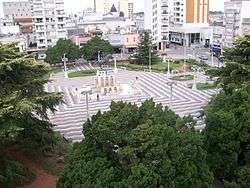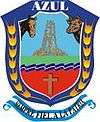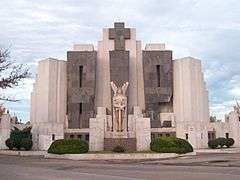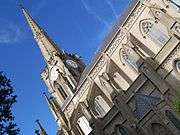Azul, Buenos Aires
Azul (Spanish pronunciation: [aˈsul]) is the head city of the Azul Partido, located at the center of the Buenos Aires Province in Argentina, 300 km south of Buenos Aires. It has 63,000 inhabitants as per the 2001 census [INDEC] .
Azul | |
|---|---|
Town | |
 Plaza San Martín | |
 Coat of arms | |
| Coordinates: 36°47′S 59°51′W | |
| Country | |
| Province | |
| Partido | Azul |
| Founded | December 16, 1832 |
| Elevation | 137 m (449 ft) |
| Population (2010 census) | |
| • Total | 55,728 |
| CPA Base | B 7330 |
| Area code(s) | +54 2281 |
| Climate | Cfa |
| Website | www |
Its principal, goods-producing economic activities are agriculture and the raising of cattle for meat exports. Home to a dynamic services sector, over 2,000 commercial businesses are registered in the city.[1]
The town was founded on December 16, 1832, following Governor Juan Manuel de Rosas' orders for the construction of a fort, San Serapio Mártir del Arroyo Azul, to guard against indigenous raids. Subsequent land grants led to the development of a stable community, and in 1895, Azul was formally declared a town by provincial authorities. The local cathedral, Nuestra Señora del Rosario, was consecrated in 1906.

The town's cemetery portal and main slaughterhouse were both designed by architect Francisco Salamone, and contain elements of Art Deco style. Built in the late 1930s, these buildings were some of the first examples of modern architecture in rural Argentina. The town was the scene of an attack on outlying Army barracks by the far-left ERP on January 19, 1974, the most violent siege of its type in the country up to that point.
Azul is home to the schools of Agronomy and Law of the National University of Central Buenos Aires. The Teatro Español, founded in the city in 1897, is among the most important of the central pampas area, and in 1992, hosted the Bolshoi Ballet.[2]
The Miguel de Cervantes Festival is held there annually since 2007, and Casa Ronco, an antiquarian library and museum, maintains among the country's best collections relating to the noted Spanish writer. The Casa Ronco is named after the collector Batolomé Ronco. Azul was declared Argentina's "City of Cervantes" by UNESCO in 2007.[3]
Climate
| Climate data for Azul, Buenos Aires Province (1961–1990, extremes 1961–present) | |||||||||||||
|---|---|---|---|---|---|---|---|---|---|---|---|---|---|
| Month | Jan | Feb | Mar | Apr | May | Jun | Jul | Aug | Sep | Oct | Nov | Dec | Year |
| Record high °C (°F) | 40.3 (104.5) |
37.8 (100.0) |
36.7 (98.1) |
33.9 (93.0) |
29.5 (85.1) |
24.3 (75.7) |
26.2 (79.2) |
33.0 (91.4) |
30.9 (87.6) |
33.3 (91.9) |
35.5 (95.9) |
40.6 (105.1) |
40.6 (105.1) |
| Average high °C (°F) | 29.2 (84.6) |
28.1 (82.6) |
25.0 (77.0) |
21.2 (70.2) |
17.1 (62.8) |
13.6 (56.5) |
13.4 (56.1) |
15.2 (59.4) |
17.8 (64.0) |
20.2 (68.4) |
23.9 (75.0) |
27.3 (81.1) |
21.0 (69.8) |
| Daily mean °C (°F) | 21.3 (70.3) |
20.3 (68.5) |
17.6 (63.7) |
13.9 (57.0) |
10.3 (50.5) |
7.5 (45.5) |
7.3 (45.1) |
8.4 (47.1) |
10.8 (51.4) |
13.7 (56.7) |
16.8 (62.2) |
19.8 (67.6) |
14.0 (57.2) |
| Average low °C (°F) | 13.8 (56.8) |
13.4 (56.1) |
11.5 (52.7) |
7.9 (46.2) |
4.9 (40.8) |
2.5 (36.5) |
2.3 (36.1) |
2.8 (37.0) |
4.5 (40.1) |
7.5 (45.5) |
9.9 (49.8) |
12.4 (54.3) |
7.8 (46.0) |
| Record low °C (°F) | 2.1 (35.8) |
2.0 (35.6) |
−1.7 (28.9) |
−4.0 (24.8) |
−7.2 (19.0) |
−10.1 (13.8) |
−10.1 (13.8) |
−8.8 (16.2) |
−8.6 (16.5) |
−5.0 (23.0) |
−3.9 (25.0) |
−1.6 (29.1) |
−10.1 (13.8) |
| Average precipitation mm (inches) | 114.5 (4.51) |
92.0 (3.62) |
131.2 (5.17) |
85.1 (3.35) |
61.9 (2.44) |
41.6 (1.64) |
44.8 (1.76) |
44.8 (1.76) |
60.8 (2.39) |
97.7 (3.85) |
93.9 (3.70) |
105.0 (4.13) |
973.3 (38.32) |
| Average precipitation days (≥ 0.1 mm) | 9 | 7 | 9 | 7 | 7 | 6 | 6 | 6 | 6 | 10 | 10 | 10 | 93 |
| Average relative humidity (%) | 71 | 75 | 79 | 81 | 83 | 84 | 84 | 79 | 76 | 78 | 75 | 72 | 78 |
| Mean monthly sunshine hours | 235.6 | 231.7 | 198.4 | 183.0 | 158.1 | 108.0 | 117.8 | 158.1 | 177.0 | 192.2 | 222.0 | 229.4 | 2,211.3 |
| Percent possible sunshine | 53 | 60 | 52 | 55 | 50 | 38 | 39 | 47 | 50 | 47 | 52 | 51 | 50 |
| Source 1: NOAA[4] | |||||||||||||
| Source 2: Servicio Meteorológico Nacional (precipitation days 1961–1990 and extremes),[5][6] UNLP (sun only)[7] | |||||||||||||
References
- Subcomisión de Turismo: Azul es Historia Archived 2010-03-17 at the Wayback Machine (in Spanish)
- Teatro Español de Azul Archived April 30, 2010, at the Wayback Machine (in Spanish)
- Clarín (26 January 2007) (in Spanish)
- "Azul Aero Climate Normals 1961–1990". National Oceanic and Atmospheric Administration. Retrieved April 21, 2015.
- "Valores Medios de Temperatura y Precipitación-Buenos Aires: Azul" (in Spanish). Servicio Meteorológico Nacional. Retrieved April 21, 2015.
- "Clima en la Argentina: Guia Climática por Azul Aero". Caracterización: Estadísticas de largo plazo (in Spanish). Servicio Meteorológico Nacional. Archived from the original on 2017-09-04. Retrieved 4 October 2017.
- "Datos bioclimáticos de 173 localidades argentinas". Atlas Bioclimáticos (in Spanish). Universidad Nacional de La Plata. Retrieved June 19, 2015.
- Municipal information: Municipal Affairs Federal Institute (IFAM), Municipal Affairs Secretariat, Ministry of Interior, Argentina. (in Spanish)
